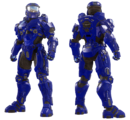MJOLNIR Powered Assault Armor/Mark IV
From Halopedia, the Halo wiki
- "You're the only ones who can use them, Petty Officer. Who else could we give them to?"
- — Doctor Catherine Halsey
The Mark IV MJOLNIR Powered Assault Armor was (despite its name) the first version of the MJOLNIR Powered Assault Armor series. The suit was issued to Spartan-II commandos on November 27, 2525,[1] and was in service until it was replaced by the Mark V on November 24, 2551.[2][note 1] A hybrid variant could still be requisitioned by Spartan personnel as late as October 2558, albeit upgraded to function with the MJOLNIR [GEN2] suite, and is notably still used by select Spartan-IIs.[3]
Introduction
Developed parallel to the SPARTAN-II program[4] by the Office of Naval Intelligence's Materials Group, the MJOLNIR powered assault armor was a radical redesign from previous large bulky exoskeletons, streamlining their design into a compact suit of armor practical for use in the field. The brainchild of Dr. Catherine Halsey, the MJOLNIR armor represented her vision of creating a slim powered exoskeleton capable of taking full advantage of the physical capabilities of a SPARTAN-II.[4] Planning and research for the revised MJOLNIR battlesuit began in 2511[5] alongside the SPARTAN-II project; over the course of fourteen years its development gave birth to many new technologies that would later see major adoption throughout the military.
MJOLNIR is a sealed system capable of extra-vehicular activity or operations in toxic atmosphere and vacuum. It is hardened against electromagnetic pulse and radiation, and has filters that are completely effective at removing toxins and bacteria from local atmosphere.[6][7]
The armor's outer shell is composed of a multilayer alloy of remarkable strength which has been augmented with a refractive coating capable of dispersing a limited amount of Covenant energy weapon impact.[6][8] Underneath the alloy shell is a thick black armored titanium nanocomposite bodysuit. Underneath that layer is a gel-filled layer. The gel layer regulates temperature and can reactively change its density in a few seconds.[6][8] The inner skinsuit is made of a moisture-absorbing synthetic material linked to an environmental control computer and the occupant's special-issue neural interface.[6][8] This network translates electrochemical signals to digital code and routes them through an interface connection at the rear of the skull.[6] Through this interface the user's thoughts commands the armor's movement and weapons and input from the on board sensors comes directly to the user's mind.[6] The synthesis of machine and mind is so fast that it is almost impossible to chart the reaction time. Unfortunately, the system is so reactive that normal human beings cannot use the suit without injuring or even killing themselves.[9] Only humans who have undergone carbide ceramic ossification, a bone-strengthening treatment shared by the Spartans, have been shown to safely operate the suit.
Sandwiched between the external armor and the internal padding is the most devastating weapon the suit carries: a layer of polymerized lithium niobocene, a form of reactive metal liquid crystal.[6] Woven by molecular tools into a super-dense layer, this layer is amorphous, yet it amplifies force, doubling lifting capability and increases reaction time by a factor of five.[4] Such technology did not exist when work began on the Mark I prototypes.[4][10]
Because of these advancements the design is more akin to an actual suit of armor as opposed to a powered exoskeleton; the user moves the suit and in return the suit moves the user. This allows for an highly compact design when compared to other combat systems. The armor contains numerous features including an integrated computer system which continuously monitors weapons, biological functions, and a limited function motion sensor system. The suit also contains a built-in rebreather system that can provide air for up to 90 minutes.[7] The suit's helmet also features imaging and video recording, and thermal sensors among other features.
In its final phase the MJOLNIR armor weighs a half ton (453.592-508.0231 kilograms),[11] and is currently the most advanced piece of tactical military hardware in human hands.[6]
Armor platforms
Throughout the Covenant War the Mark IV saw several generational design changes and became a testbed for new technologies and hardware to help improve its integrity and efficiency in certain combat conditions.[12] While some of these variants are rumors and have never been witnessed in the field, others have become common knowledge.[13] By 2535 fourteen variants had already been developed.[14] Mark IV went through multiple external design iterations[15] and variants designed for a specific purpose tend, by necessity, to look different from the contemporary core model.[16] However, each generational "Mark" is categorized by its internal components and software suit, not by its superficial design: therefore, while a first-generation Mark IV suit may look drastically different from a third-generation suit, they are still essentially the same model.[16]
Functional prototype
The Materials Group developed this prototype to test the technologies that were being developed for the MJOLNIR battlesuit. In February 2525 this model was sent to Naval Special Warfare for evaluation and final testing. Over the next four months the model was tested to ensure proper function and to evaluate its capabilities. The prototype was built and fine-tuned for the SPARTAN-II supersoldiers. A test was conducted to see if a normal human could operate the suit. Because of an override in the prototype's safe mode to prevent unintended use, the operator was killed by his own muscular twitch.[17][9] A short time after the failed demonstration limited production of the MJOLNIR battlesuit was approved.[17]
Initial production model
Five months after production began the MJOLNIR PAA entered service.[17] The initial version was bulky, angular, and restrictive in mobility. Due to its design philosophy being centered around a human insurrection this model was not adequately prepared for dealing with advanced alien technology and weapons.[14] Although highly advanced the suit entered service in an accelerated state due to the Covenant threat. As such, upgrades to the suit were already in the works when it was issued to the Spartans;[14] at least seven variant models had been introduced by April 2526.[18][19] In 2531 the suit was replaced by a generational upgrade to better combat the alien threat.[14][12]
Final production model
By 2535 the MJOLNIR system had become the single most expensive item ever produced by the UNSC.[20] It had been intended as a continuous, pioneering effort to shatter technological barriers. However, with each suit costing as much as a destroyer to manufacture[21] the budgetary commission overseeing the MJOLNIR project mandated a simplified generational system to categorize, prioritize, and serialize development neatly into fiscal-year budgets. Thus the "Mark" system was added to MJOLNIR, with the current version being retroactively designated "Mark IV" to suggest continuity with the powered exoskeleton program that had preceded MJOLNIR's development.[22]
With the adoption of the "Mark" categorization, an updated model of the suit that had entered service four years earlier was adopted as the standard-issue suit. Its design would inform all future "Mark" generations. The third-generation suit included numerous improvements not available at the beginning of the war, including a standardized vacuum survival system, standard fusion power, and a new radar sensory package.[22]
Armor variants
Advanced Hardware Program
The MJOLNIR Advanced Hardware Program concerns the development and furthering of hardware and technologies for testing, evaluation, and incorporation into later versions of the MJOLNIR armor. The original goal of the program was to produce new technologies to aid the Spartan-IIs in the war against the Covenant,[13] such as the prototypical energy shielding tested by Red Team in 2531.[23][24] Any changes in appearance of the armor are for research and development of future MJOLNIR components.[13]
Known variants
Unidentified variants
Mark VI-like variant (2525)
John-117 was equipped with this variant during the Battle of Chi Ceti on November 27, 2525. It resembles a cross between Mjolnir's initial production model and the later Mark VI. Cortana's upgrade of John's Mark VI suit superficially resembles this model, particularly in the shape of the helmet.[25]
John wearing the variant aboard the Covenant vessel Unrelenting
CQB-like variant
Though the CQB variant proper did not enter service until 2535, the helmet's architecture saw use as early as 2525,[26] An armor configuration almost identical to the later Mark VI/C variant was field-tested in 2531.[27]
- Mark IV CQB.png
Samuel-034 wearing a proto-CQB helmet at Chi Ceti IV in November 2525
EVA-like variant
A Spartan-II was issued this helmet during the Battle of Chi Ceti.
Hermes-like variant
Kelly-087 wore this helmet during the Battle of Chi Ceti. It is very similar in appearance to the [GEN2] Hermes helmet she would later wear.
Unspecified variant
During the Battle of Chi Ceti, a Spartan-II tested out this helmet.
Mark VI-like variant (2526)
John-117 was outfitted with this variant during at least three separate engagements during the Human-Covenant War. Considerably slimmer than Mjolnir's initial production model, this variant bears a strong resemblance to the later Mark VI.
John wearing the variant on Circinius IV in 2526
- 1771875-gallery.png
John's armor during the Harvest campaign in 2531
John wearing the armor during Operation: WARM BLANKET in 2546
Air Assault-like
During the Battle of Circinius IV in April 2526, Kelly-087 utilized a variant that had similar architecture to Air Assault armor. She wore the helmet in conjunction with the Mark IV (b) armor.[19]
Gray Team variant
Jai-006 of Gray Team wore a distinct variant of the Mark IV in 2535. Another member of Gray Team wore armor with a wider left pauldron.[28]
A member of Gray Team wearing the variant at the Rubble
Mark VI-like variant (2546)
Solomon-069, Arthur-079, and Fred-104 utilized this helmet during Operation: WARM BLANKET. The only notable difference between this variant and the similar model John wore during the operation is the more prominent external rebreathers.
[GEN2] upgrade
After the Human-Covenant War, a GEN2 variant was developed that uses many components of the original Mark IV armor after firmware updates. This suit is still used as of October 2558.
Inner armor components
- Inner skinsuit:
The inner skinsuit is made of a moisture-absorbing synthetic material linked to an environmental control computer and the occupant's neural interface. It controls the suit's temperature and actively changes how the suit fits the user.[9]
On top of the inner skinsuit is a gel-filled layer, which regulates the temperature of the suit and can change its density to conform to the wearer's shape. The temperature inside the suit is controlled by the moisture absorbing cloth suit underneath the hydrostatic layer. The hydrostatic gel layer can also be pressurized to various levels to potentially save the wearers life should the wearer be subjected to high G forces or a high velocity impact; however, over-pressurizing this layer can cause nitrogen embolisms.[29][30]
Fitted in between the outer plates and the inner padding, is a layer of liquid crystal within a piezoelectric material that deforms along a preferred axis when exposed to a electric charge.[31] This layer acts as a sheath or a suit artificial muscle; this reactive piezoelectric effect increases the strength, reaction time, mobility, speed, and all around physical performance of the suit's user.[31] The material is amorphous, thus circumventing a major obstacle in its design: custom-fitting millions of the polygonal pieces under the second armor layer.[32] Knitted together at a molecular level the liquid crystal material is merely "poured" into a multilayered Sierpinski capillary system where microelectric fields can direct crystallization geometries.[32] The only downfall is the materials production, which involves classified super-toxic precursor materials and requires a zero-gravity environment.[32] As such this layer accounts for over eighty percent of the MJOLNIR armors cost of construction and materials.
The pressure seal is a vital component to the MJOLNIR system as it keeps the system airtight whether underwater, in vacuum, or in a hostile atmosphere. The seal is very strong and will only break under extreme pressure, such as in a high velocity impact or when the hydrostatic gel has been over-pressurized.[citation needed]
- Titanium nanocomposite bodysuit:
Sandwiched between the external armor and the internal padding is a thick, black armored bodysuit. This suit has numerous functions, small but vital to the safety and survival of the wearer. The bodysuit is made of a titanium-based material, making it very strong and yet very flexible. It also serves as another layer of protection against ballistics attacks and is coated with a heat resistant material to disperse heat from plasma weapons.[33]
- Lock-down system: The lock-down system protects muscles and joints from traumatic, high-impact injuries by seizing the suit into a rigid posture through modifying the density of the hydrostatic gel layer.[34][35][36][37][note 2]
Outer shell and components
The outer shell of the MJOLNIR armor is comprised of a thick titanium alloy. This alloy is very resilient, being nearly impervious to small arms fire. While enough impacts from armor-piercing rounds will breach the outer shell, the suit can take a few glancing blows from them without compromising the armor. The outer shell of the MJOLNIR suit is covered with a refractive coating to help disperse the heat discharged by Covenant energy weapons. However, one or two direct hits from any plasma weapon will compromise the armor plating.[33]
- Integrated Communications Helmet:
The MJOLNIR helmet (properly the Integrated Communications Helmet) is one of the most vital aspects to the MJOLNIR armor system. It is made of titanium and features a heads-up display (HUD) that links to the brain and hands; the HUD can identify equipment and display information about it when it is picked up by the wearer. It also features an environmental control unit that includes filters to remove toxins from the atmosphere, as well as a rebreather to automatically supply oxygen to the wearer during EVA. In addition the helmet contains thermal and motion sensors, communications, solar-powered lighting, and imaging and video gear.[22]
The helmet's most important feature is the direct neural-interface system which connects to a Spartan's neural implants. Two core processor chips are implanted into the subject's skull in the rear of the head. This is essentially comparable to an on-board computer using parts of the human brain for processing - when the connector at the rear of the subject's head and receptors in the brain link to the helmet's on-board sensors it creates the neural link needed to move the MJOLNIR suit.[22]
The first-generation helmet was retained for use with the 2535 model[38] and was later upgraded for use with the Mark V.[39]
- Titanium alloy outer shell/chest:
The titanium chest plating provides maximum ballistics protection across all generations of the Mark IV. The original version consisted of wide plating to allow for free rotation of the head and neck; the external microphone was located below the collar area and below that an environmental control unit. This model also had large arm sockets and the waist area consisted of free-rotating bearings which lock into the lower body or jumper armor section. Later versions of the chest plates are more angular and are joined via a hinge system on both the central brace and the shoulder connectors, allowing them to rise and fall with the user's movements.[22]
- Titanium alloy outer shell/arms:
The first version's shoulder and arm plating consisted of an organic shape with larger shoulder area for ample protection; the upper assembly piece sat flush inside the upper-arm armor. The elbow armor was hinged to fit flush when the wearer's arm was straight, making hyperextension impossible without force adequate to destroy the plating. The forearm armor is the same with locking pieces to prevent over-rotation and the lower portion is attached to the handguard. The range of motion is adequate for firearm use and hand-to-hand combat, however the guard prevents hyperextension of the wrist. Later revisions to this armor discard this for more nanofabricated pieces and more mobility focused plating. The pauldrons are mounted at a downwards diagonal angle at the upper edge of the shoulder, independently of the armor below them. This allows the lower arm pieces to slide and rotate beneath them, and when the arms are raised, the angled pauldrons move with them.[22]
- Titanium alloy outer shell/waist:
The MJOLNIR armor's torso plating is connected to the upper-torso plating by free-rotating waist connectors the waist plating contains ammunition/utility pouches. The lower-abdomen plate connects into a track for upper torso bending, the codpiece is connected to the femoral-artery armor.[22]
- Titanium alloy outer shell/legs:
The MJOLNIR PAA's leg armor consists of two major plating sections, with a third piece protecting the knees. The earlier version of the armor consisted of the thigh armor which is actually two sections held together by two locking collars, the knee pads are secured on the sides. The lower leg contains reinforced piezoelectric bladders which secure ankle and lower legs to prevent impact injury from high-elevation jumps. The boots consist of 15mm-thick soles, which are secured by a foot covering hinge locking bolt.[22]
- Magnetic weapon holder strips:
Available on updated outer armor components of the Mark IV the magnetic strips are very small yet powerful magnets placed on the legs, waist, and back of the suit and is used to hold any equipment with a magnetic property. The suit also contains a magnet system on the boots of the MJOLNIR suit that allow its wearer to stay attached to a metal surface in zero-G environments and can be toggled on or off by the wearer. In addition to the magnetic holders, the default Mark IV is also equipped with utility pouches on the waist and a clip for a holster capable of accommodating most UNSC sidearms.[14][22]
- Biofoam injector port:
The biofoam injector is a port where a direct supply of biofoam or other medicines must be administered from a standard military first aid kit when the wearer is injured, as the suit does not hold or generate its own supply inside the suit.
- Fission reactor:
Integrated in the limited production model of the MJOLNIR PAA the nuclear fission reactor was the MJOLNIR armors source of power, the reactor was built into the suit and allowed for unlimited power. However, because of the delicacy and radioactive nature of the fission reactor its use was limited until it was replaced with a micro-fusion plant in the final production model in 2535.[22][40]
- Microfusion reactor:
Integrated in the final production model in 2535, the microfusion cell is the most vital component to the MJOLNIR system as it provides power to all components of the MJOLNIR armor. The reactor is built into the suit and allows for nearly unlimited power. The fusion reactor in all versions of the MJOLNIR armor is half the size of a normal fusion pack that conventional marines carry around.[41]
The power supply control unit is integrated into the miniature fusion reactor located on the back of the MJOLNIR suit. It provides power distribution to the suit's functions and can be overloaded when too much power is allocated to one function or all functions for long periods of time.
This system functions as a self-destruct mechanism in order to prevent a dead Spartan's armor from being compromised by hostiles. It is activated by a series of digits that only the Spartans know. When engaged, it produces a reactor overload that burns everything within a ten-meter radius, then produces a large blast.[42]
- Thruster pack:
Located at the back of the suit beneath the fusion reactor, this component provides the ability to propel the MJOLNIR user over short distances and maneuver in zero-gravity environment.[43][18][note 3]
In-game information
Halo 5: Guardians
Unlock: Mythic REQ card
- Helmet Description: A battered Mark IV helmet once worn by the Master Chief is the last thing that SPARTAN-IV candidates see before beginning their grueling evaluation and preliminary augmentation cycle.
- Body Description: As the basis for the GEN1 Mjolnir standard, many components of the original Mark IV can be used with GEN2 techsuits and VISRs after firmware updates. This hybrid GEN2/MARK IV [GEN1] suit is still used by select Spartan-II's.
Available Skins: Arcadia
Arcadia Unlock: Mythic REQ card
Trivia

|
Browse more images in this article's gallery page. |
- The sketches of the limited-production Mark IV in Doctor Halsey's journal are almost identical to an early concept for the MJOLNIR armor, apart from the helmet.
- Kelly-087's and Fred-104's Mark IV suits in Halo 4: Forward Unto Dawn are kitbashed from the Air Assault and Mark V[B] suits used in the live-action "Deliver Hope" trailer for Halo: Reach. Fred's armor was later canonized as the Mark IV(b), though Kelly's remains unidentified.[44]
- During the development of Halo 5: Guardians, the Mark IV armor was codenamed "A088" when it was conceived.[45]
Gallery
Production
Early drawings and renders of Mark IV that did not make the cut into the relevant media.
An early model of the MJOLNIR in Halo Wars alongside a Hellbringer.
Another early design of the MJOLNIR in Halo Wars. This version is featured in the game's announcement trailer.
- 1775194-gallery.png
Concept art of the Mark IV version featured in Halo Legends: The Package.
Concept art of the Mark IV for Halo 5: Guardians.
Normal gallery
Jerome-092 in his first-generation suit.
Cal-141 wearing a suit resembling the original model on Heian in The Babysitter.
John-117 in his newly issued MJOLNIR armor in Halo: Fall of Reach.
The MJOLNIR Mark IV in Halo: The Fall of Reach - The Animated Series.
Various types of Mark IV armor worn by Blue Team during the Battle of Chi Ceti IV.
Models of the Mark IV for Halo 5: Guardians.
Front and back of the Mark IV for Halo 5: Guardians.
Red Team wearing MJOLNIR Mark IV in Halo Wars 2.
Douglas-042's Mark IV being crushed by Atriox's power gauntlet.
List of appearances
Notes
- ^ Halo: The Fall of Reach states that the Mark V was issued on August 29, 2552. However, the aforementioned Weekly Update and Dr. Halsey's personal journal retcon this, instead stating that the Mark V was issued on November 24, 2551. The test performed by John-117 was intended to gauge the pairing of the Mark V suit with a piggy-backed AI, not to observe the suit's performance per se. Halo Waypoint's MJOLNIR Project 2 video erroneously presents the date given in the novel as valid.
- ^ No source has stated that the Mark IV was equipped with a lock-down system. However, this article assumes that the Mark IV did possess such a system, due in part to Jorge-052 being able to lock his upgraded Mark IV/G armor in the level Tip of the Spear in Halo: Reach.
- ^ The Halo 4 Prologue cinematic and Halo: The Fall of Reach - The Animated Series depict the Mark IV with built-in thrusters. In the novels, however, the Mark IV is described as requiring a separate thruster pack attachment for maneuvering in a vacuum. Halo Waypoint notes that integrated thruster packs were added in a later phase of MJOLNIR GEN2 upgrades (presumably in 2558), despite the GEN2 models in Halo 4 appearing to possess the hardware already. It is unlikely that the Mark IV would feature maneuvering jets only for the technology to be abandoned until GEN2's release. The depictions of the Mark IV with built-in thrusters may stem from the admittedly non-canonical use of John-117's unique Mark VI armor in the Prologue cinematic, while the use of built-in thrusters in Halo: The Fall of Reach - The Animated Series may be due to simplification for the sake of the visual medium.
- ^ Josh Holmes has confirmed that the use of John-117's unique Mark VI model to represent the Mark IV in Halo 4's Prologue cinematic is not canon. The geometry was recycled because the production team did not have time to create a unique Mark IV model that would have only seconds of screen time. Halo 4: The Essential Visual Guide notes that John's upgraded Mark VI suit resembles an earlier Mark IV line (likely as a tongue-in-cheek nod to the cutscene), though this does not mean that the two designs are canonically identical. The cutscene uses the same model to represent the Mark V suit John canonically wore when he met Cortana, further invalidating its canonicity.
Sources
- ^ Halo: The Fall of Reach, page 113 page 136 (2010 edition)
- ^ Bungie.net: Bungie Weekly Update: 01.29.10
- ^ Halo 5: Guardians
- ^ a b c d Sybex Halo PC Strategy Guide, page 5
- ^ Dr. Halsey's personal journal July 30th, 2511 entry
- ^ a b c d e f g h Master Chief's Armor: An Overview
- ^ a b Halo: The Fall of Reach page 120 page 143 (2010 edition)
- ^ a b c Halo: The Fall of Reach page 114-115 page 137 (2010 edition)
- ^ a b c Halo: The Fall of Reach, page 115 page 138 (2010 edition)
- ^ Halo: The Fall of Reach page 70 page 89 (2010 edition)
- ^ Halo: The Fall of Reach page 2 page 16 (2010 edition)
- ^ a b Halo Waypoint: The MJOLNIR Project Part 1
- ^ a b c Halo Encyclopedia pages 88-89
- ^ a b c d e Dr. Halsey's Personal Journal January 7th, 2535 entry
- ^ The Halo Bulletin: 7.18.12
- ^ a b Halo Waypoint: The MJOLNIR Project Part 2
- ^ a b c Dr. Halsey's Personal Journal June 30, 2525 entry
- ^ a b Halo: The Fall of Reach - The Animated Series
- ^ a b Halo 4: Forward Unto Dawn
- ^ Halo: Ghosts of Onyx page 45
- ^ Halo Legends, Halo: The Story So Far
- ^ a b c d e f g h i j Dr. Halsey's personal journal January 7, 2535 entry
- ^ Halo: The Essential Visual Guide, page 119: "Energy shielding was a key feature of Mark V, although other Spartan squads had field-tested prototypes of this technology as early as 2531."
- ^ YouTube: Halo Canon Exclusive Interview
- ^ Halo 4: The Essential Visual Guide, page 10
- ^ Halo Waypoint: GrimBrotherOne: Nothing has changed about the CQB variant of the Mjolnir armor system. Samuel is utilizing a developmental helmet permutation that shares visual cues with the eventual CQB. This kind of cross-germination of physical shape and design between all Mjolnir platforms was pervasive in the early development of Mjolnir at the Materials Group facilities.
- ^ Halo Legends, "Homecoming"
- ^ Halo: The Cole Protocol cover art
- ^ Halo: First Strike page 13 page 20 (2010 edition)
- ^ Halo: Ghosts of Onyx page 36
- ^ a b Dr. Halsey's Personal Journal July 11th, 2511 entry
- ^ a b c Dr. Halsey's Personal Journal September 1st, 2525 entry
- ^ a b Halo Encyclopedia page 90
- ^ Halo 3, level Arrival
- ^ Halo Encyclopedia, page 91
- ^ Halo: Reach, campaign level Tip of the Spear
- ^ Youtube: Halo Reach Legendary Edition developer commentary, part 4
- ^ 2535 Mark VI schematic
- ^ Halo: Reach Armory - hosted by Ready Up Live
- ^ Halo: Ghosts of Onyx page 45
- ^ Halo: The Fall of Reach page 114 page 137 (2010 edition)
- ^ Halo: First Strike, page 315
- ^ Halo 4, Prologue
- ^ Halo Waypoint - Frederic-104
- ^ The link reveals the armor was named A088 during production
| |||||||||||||||||||||||||||||||||||||||||||||||||||||||||||||||||||||||||||||||||||||||||||||||||
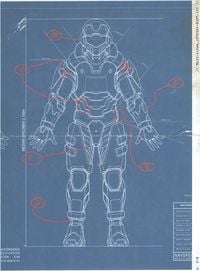











![The Mark IV adapted for MOLNIR [GEN2]](https://halo.wiki.gallery/images/thumb/e/e8/H5G-MarkIV.png/58px-H5G-MarkIV.png)


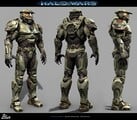
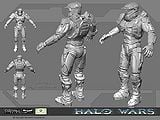

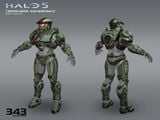








![John-117 wearing the non-canonical Mark IV design from Halo 4's Prologue.[note 4]](https://halo.wiki.gallery/images/thumb/5/5f/Covenant_assault_-_Aftermath.png/200px-Covenant_assault_-_Aftermath.png)





